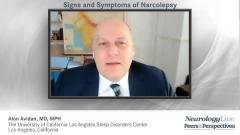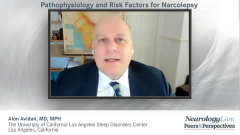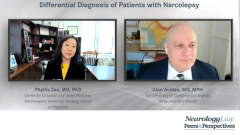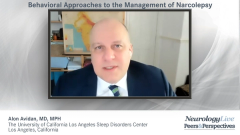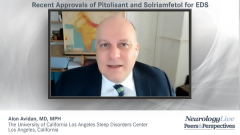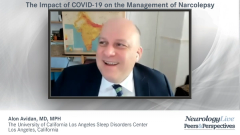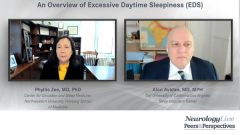
Future Improvements in the Management of Narcolepsy
Expert neurologists discuss advancements in the management of narcolepsy including new drug formulations and provide take-home messages for how to improve diagnosis and treatment in the future.
Episodes in this series

Phyllis Zee, MD, PhD: What do you know about any new things on the horizon for the treatment of narcolepsy? What is exciting on the horizon for me is the potential development of orexin receptor agonists. Until now, our medications have mainly targeted symptoms and perhaps part of the pathophysiology but not the orexin system directly. We think this is 1 of the primary causes of narcolepsy, so those are under development. Anything else that you think is exciting in telemedicine?
Alon Avidan, MD, MPH: Absolutely, the orexin receptor agonists are exciting, in a similar fashion that the orexin receptor antagonists were initially proposed for the management of insomnia. Remember, we always tell our patients and colleagues never to use this orexin antagonist on patients with narcolepsy. We are certainly appreciating that the mechanism targeting orexin by agonists is exciting. The other agents on the horizon are the low-sodium formulation of oxybate, which is certainly interesting. The once-a-day oxybate formulation is interesting. Remember, when we tell patients to take sodium oxybate, they have to take it twice before going to bed, and they have to wake up 2 to 4 hours later to take a second dose. Certainly, with using some of the GABA-B receptor agonists, the norepinephrine inhibitors, it is exciting that we have even more interest in a focused approach for idiopathic hypersomnia that has remained a rather elusive and forgotten area as a disease state. We have often applied treatments for narcolepsy that do not really work for those types of patients.
Phyllis Zee, MD, PhD: By having these pharmacological therapies that target mechanisms, such as something like pitolisant targeting the histamine system, we are probably going to see more of those in development. There are also other H3 inverse agonists in the pipeline.
Let’s wrap this up by thinking about some of the take-home messages for our viewers. I can start: It is that excessive daytime sleepiness is common. It is common in patients with neurological disorders, and narcolepsy is a neurological disorder. Although it may be less common, it is something that we need to be aware of, and there are some distinct symptoms and signs. Identifying cataplexy is probably key, and it can be quite subtle. Therapies need to be targeted at the individual, and we have a broader set of behavioral strategies as well as pharmacological strategies to tailor therapies for our patients. First, the most important thing is to think about narcolepsy in your patients with excessive daytime sleepiness, even if they have depression, obstructive sleep apnea, or other neurological conditions. It is still something to be aware of to raise that awareness. Dr Avidan, I will let you give your take-home messages.
Alon Avidan, MD, MPH: Thank you, Dr Zee. It was a pleasure working with you again. I echo the same sentiments that you mentioned. I would add also that narcolepsy is often a forgotten disorder, particularly in pediatrics. It is not thought as a pediatric condition, yet most patients with narcolepsy will present to the pediatrician, so this is a real opportunity.
The other issue relates to the fact that more than two-thirds of patients with narcolepsy who are on treatment will report persistent daytime sleepiness. It tells us that most patients find their medication is helpful, but it does not address all attributes of narcolepsy, and it does not address the daytime sleepiness to its optimal level. This is the most debilitating symptom for these patients, yet the majority feel that there is still room for improvement.
Here is an anecdote to leave our audience: Keep seeing your patients to see how well they are doing, particularly postpandemic, and screen and look for the emergence of cataplexy. We have seen a number of patients with type 2 narcolepsy and no history of cataplexy present with cataplexy much later in time.
We should be seeing these patients, screening out for other symptoms of narcolepsy that may emerge later on, and being mindful of looking out and screening patients when they have persistent daytime sleepiness, and looking for sleep apnea. A lot of these patients may gain weight, particularly in the setting of the pandemic, and they may develop sleep apnea. Depression can also increase weight through inactivity and through the use of antidepressants. We owe it to our patients to keep looking, following up in time, and tailoring therapy as time progresses according to new challenges and symptoms that they may develop.
Phyllis Zee, MD, PhD: Thank you, Dr Avidan, for joining us in this discussion. Great information. I personally enjoyed this tremendously. Thank you for watching this NeurologyLive® Peers & Perspectives® program. Please subscribe to the e-newsletter to receive upcoming Peer Exchanges® and other great content in your in-box.
Transcript Edited for Clarity
Newsletter
Keep your finger on the pulse of neurology—subscribe to NeurologyLive for expert interviews, new data, and breakthrough treatment updates.

